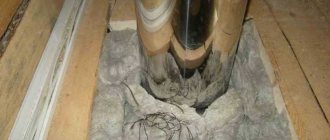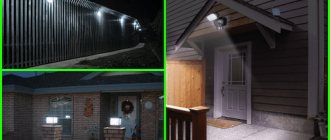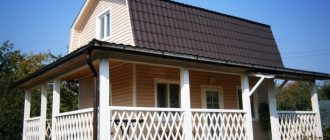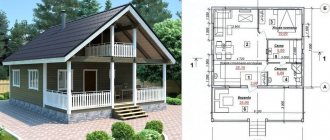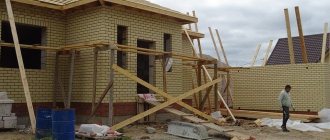Properly planned and equipped drainage system in a private house ensures a comfortable life for the owners and guarantees a long service life of the building. After all, a modern cottage is not just a structure, but a complex of interconnected systems.
Is it possible to imagine such housing without running water and sewerage? No. Therefore, a drainage project with a layout of the main components is first developed. Let's figure out together how calculation work is carried out and installation is carried out.
Methods for draining water from the roof of a country house
The main goal that is pursued when organizing drainage for a country house is to drain water in such a way that walls and blind areas do not flood and puddles do not form on the site. A gutter for a dacha is chosen based on the structural features of the roof, aesthetic preferences and financial capabilities. There are three main ways to drain water
:
- organization of water drainage using pipes and gutters
; - using a chain
instead of a pipe to drain water;
Non-standard solution for drainage Source muratordom.com.ua
- use of overhead gutters
on the roof eaves.
The most widespread method of draining water is using pipes and gutters. Let's take a closer look at its features.
Groundwater and its dangers
Groundwater can also pose a danger to the site. If your house is located near a river, lake or even a swamp, then you can be sure that there are some on the site. The danger of groundwater lies in the fact that it lies in the depths of the earth. If water from the house flows there during heavy rains, then there is a high probability of disturbing the balance and stability of the house, which may subsequently lead to its collapse. It is for this reason that it is so important to properly drain rainwater from a residential building.
Types of drainage systems
There are a huge number of options for drainage systems, which differ in size, material from which they are made and the manufacturer. The choice of one option or another depends on financial capabilities. Let's look at the main types of drainage systems.
A drain made of metal in a polymer film is the most reliable, but at the same time the most expensive option. In the manufacture of its elements, steel with a thickness of 0.5-0.8 mm is used, which is coated on both sides with a special polymer. This ensures that the operation of this drainage system is possible in any climatic conditions; in addition, the wide range of possible shades of the film allows you to select the desired shade that is ideal for the building. The main advantages of such drainage systems are their following qualities:
- long service life
, during which the original shape is not deformed; - high strength
;
corrosion resistance
Metal with a polymer coating has increased resistance to corrosion Source arttn.ru
Another option for a drainage system is a system made of galvanized metal 1-2mm thick. The main advantages of this type are low price and ease of installation. It should also be noted that elements of this type are resistant to mechanical damage and temperature changes.
Plastic drainage systems have gained particular popularity recently. Installation of such a system is quite simple, in addition, it is resistant to corrosion and ultraviolet radiation, as well as a long service life.
Recently, homemade drainage systems have become common. Their main advantages are minimal cost, speed of assembly and the absence of any technology. Disadvantages include low quality, unpresentable appearance, low functionality and the need for periodic repairs.
Do-it-yourself storm drainage system in a private house
Before you start purchasing materials for the drainage system, you should make sure it is necessary. It is important to find out the level of groundwater during the peak period of its accumulation.
This can be done in the spring, immediately after the snow melts, and during the autumn rains. To find out, exploratory water drilling is carried out to a depth of three or four meters.
Uponor drainage and storm drainage. Webinar 2021
The presence or absence of nearby subsurface water is determined by the water content in the soil from the pits. Based on the results of the study of the samples, a decision is made on the need for deep drainage for a country house.
An important indicator is the water level in the water intakes closest to the site - wells or boreholes.
Having decided on the need to install a drainage system, it is advisable to carry out a geo-survey of the area in order to determine the slopes on it, and therefore the direction of flow.
This is especially true for shallow and deep contours. Surface tray systems for a country house can be made according to the building level.
Designing a drainage system for a country house
This is the most important stage of creating a drain from the site. It allows you to reliably calculate the amount and composition of material costs for the acquisition of components:
- Types, quantities and sizes of drainage pipes.
- The need for connecting parts - fittings.
- Types of drainage channels according to their depth.
- Number and type of trays for surface stormwater drainage.
- Storage tank capacity.
- Dimensions of pipes for the manufacture of inspection and drainage channels.
- Calculate the need for building materials, including the amount and fraction of gravel, the footage of geotextile fabric.
If you carry out a simple preliminary design of a drainage sewer system for a country house yourself, then in this case it must be shown to a specialist in this area of PGS design. If necessary, make appropriate changes to it and only then begin purchasing the necessary materials.
Depth of the underground part of the system
The closer to the surface the drainage pipe is located, the more actively it absorbs moisture accumulated on the surface. The depth of the depth can be from 15 centimeters.
But if the pipe is located on the treated area, then you need to take into account the depth of digging up the earth, which can be up to 30 centimeters. Shallow gutters, being at the specified depths, thaw quite quickly and remove water from the area, preventing its significant accumulations.
Drainage and storm sewerage. Upon arrival. Uponor. Khimki. Moscow region.
As for buried collectors for storm drainage of a country house, operating on the groundwater horizon, this indicator depends on the depth of soil freezing. Below this zone, the drainage system actively removes water throughout the year.
Slope of underground communications
This indicator is worth paying close attention to. The fact is that when the slope of 3 millimeters per meter of pipeline is exceeded, the nature of the flow changes. It is doubtful that the water in the storm drain is clean.
We suggest using our online calculator to calculate the slope of a gravity sewer.
As a result of exceeding the flow rate, the polluting components do not have time to completely drain along with the liquid and partially remain in the pipe. Gradually, the amount of precipitation increases, leading to blockage.
Such a dense layer of it can be removed from the storm drain of a country house only with a jet of water under pressure.
The most dangerous phenomenon can be considered a negative slope, as a result of which the flow can occur very slowly, and water will constantly be present in the system.
The basis for installing drainage is a gravel backfill. Its formation needs to be given special attention. Qualitative measurements when installing a drain can be made with a laser or an extended building level.
The minimum slope for storm drainage is 0.3-0.5 centimeters per meter of pipeline, the maximum is no more than 4-5.
Installation of storm water inlet
The decisive indicators for assessing the selected storm water inlet are the volume of liquid that it can pass through itself at the time of maximum precipitation. Therefore, the determining indicator in this case is data on the amount of moisture falling in a particular area. Special cards have been developed for this.
The rapid removal of water through the storm drainage system of a country house not only allows free movement around the site, but also protects the foundation from the destructive effects of moisture.
Water enters the rainwater inlet from a drain on the roof of the building. For effective operation, the jet must be directed exactly into the middle of the receiving funnel.
When installing these devices, it is necessary to fulfill a number of requirements to ensure long-term operation of these devices:
- At the installation site, a hole corresponding to the size of the device is torn off. Its depth should be approximately 30-40 centimeters greater than the vertical size of the product.
- Arrange a backfill with gravel for the substrate, pour water on the layer and compact it thoroughly, providing a gap between the body and the backfill of up to 5-6 centimeters for concreting.
- The distance between the side walls of the recess and the body should be at least 3-4 centimeters.
- Connect the water intake pipes to the rainwater inlet and install it in its permanent location. In this case, it is necessary to adjust its height so that the grille is at the level of the blind area around the house.
- Concrete the rainwater inlet body, install an internal partition and a filter liner, if provided for by the design.
A storm drain in a private house is installed at the final stage of its installation for the entire site and is connected either to a storage tank or to a discharge device into the city sewer system or outside the site.
When starting such a responsible operation as installing a storm drain in a country house, you need to carefully study all the standards and rules and select the right materials for installation.
HOW STORM SEWAGE IS MADE
When installing storm sewer systems, SNiP number 2.04.03-85 is used, which regulates the requirements for the installation of external sewer networks. In this case, it is necessary to comply with both the sequence of actions and the technical requirements for materials and work.
Video description
How to organize drainage in a country house from sewer pipes is shown in the video:
See also: Catalog of companies that specialize in the installation of water supply, sewerage, drainage and drainage systems
Drainage systems differ in the shape of the pipe section: round and square. Round ones have a more aesthetic appearance and are easier to install. Square ones are cheaper and are used in buildings that have a complex shape and contain a large number of corners and turns.
Depending on the placement of the drainage system, the following types are distinguished:
- Organized external water drainage
. The most common type of drainage, in which water is drained through a system located on the outside of the building. - Organized internal drainage
. Most common in multi-story construction. A peculiarity of this type is the placement of elements of the drainage system inside the object, next to the external walls. - Unorganized water flow
. It is used only in buildings of simple construction with a pitched roof and provides for water drainage directly to the ground.
External and internal drains Source swtor-guild.com
Main functions of a storm drain
The main purpose of storm drainage on the territory of a personal plot is to ensure high-quality drainage of the soil and prevent it from becoming waterlogged. Thus, there will be no flooding and subsidence of the foundation of the house and other buildings located on the site, as a result of which this or that building may lean or begin to go into the ground, and cracks may form on its walls. Excess water in the soil leads to gradual destruction of the foundation, and therefore water removal will significantly increase the service life of the building.
IT IS IMPORTANT TO KNOW!
In areas with clay soil, it is simply impossible to do without storm drainage - such soil does not allow water to pass through well, and therefore, after the snow and rain melt, puddles remain on its surface for a long time. The accumulation of water in the fertile soil layer leads to diseases of the root systems of plants, which can even cause the death of plantings.
The purpose of storm drainage is not only to drain the territory of the land plot, but also to clean the drained water from sand and other contaminants. The water that passes through the drainage system has a relatively high level of purity, and therefore does not lead to pollution of water bodies and surrounding soils.
Types of drainage system organization
When organizing a drainage system at your dacha, you can use several options for collecting water from gutters (that is, organizing drainage elements on the ground):
- Open drainage system
- involves the use of ditches for collecting water located on the surface of the summer cottage. - Closed system
- drainage pipes are used for drainage in the ground, located around the entire perimeter of the house or site. Most often, perforated plastic pipes or cross-linked polyethylene pipes are used for these purposes.
Closed drainage system Source vseogarage.ru
- Backfill drainage
is carried out using bricks and crushed stone. This type of drainage is short-lived and therefore not used often. - Surface drainage system
is a water drainage system using trays with grates to collect water. Water flows into the trays through special storm inlets. - Combined drainage system
. Provides for the simultaneous use of surface and closed drainage systems (drains on the ground and in the ground).
A properly organized drainage system will not only solve the problem of water drainage during rain, but can also contribute to a significant decrease in the groundwater level in a summer cottage.
Drainage ditch
One of the simplest and most accessible devices that allows you to drain water from a site is a drainage ditch. It is best to do this if the area has a slope in one direction.
It comes off to a depth below the freezing level of the soil. It is important to maintain a slope along the entire length towards the water drainage. Its size should be up to 3-5 centimeters per meter of length. This slope allows water to flow slowly enough, taking with it particles of soil, otherwise rapid silting of the storm drain of a country house may occur. See the rules for laying sewer pipelines in the ground. Storm sewerage in a private house in its own way
At the bottom of the ditch, approximately a third of the depth, a layer of wild stones or concrete scrap is placed. Then you need to pour coarse gravel, sand and cover it all with geotextiles. It will prevent rapid silting of the drainage channel. Ideally, the drainage ditch is led into the nearest storm drainage well.
In modern conditions, pipes made of various materials are used as drainage systems - steel or plastic. For greater strength, products with a corrugated wall are used for conductors of the second option. This design increases the radial strength of the product.
Storm sewer drainage ditches on the site can also be open, which simplifies their operation.
They come in the following types:
- perimeter - come off along the perimeter of the area that needs to be protected from excess moisture;
- the main ones are essentially the main channel of the river, to which tributaries converge in the form of additional drains.
Elements of the drainage system
The main elements of the drainage system are:
- Gutters
. Their main function is to collect water from the roof slopes and direct it into the pipes. - Funnels
. Serve to connect the gutter to the pipe. - Connectors (couplings)
. Necessary for connecting gutters or pipes to each other. - Pipes for drainage
. Designed to drain water into a drainage or drainage system. - Turns and angles (knees and bends)
. With their help, you can bypass all protruding elements when installing a solid drain. - Plugs and fastenings (clamps, brackets)
.
Elements of the drainage system Source bydlokoder.ru
Useful tips for arrangement
If there is a need to turn the pipe 90 degrees, it is better to organize two 45-degree bends. This will reduce the sharpness of the turn and create minimal resistance in the network.
If a turn of 90 degrees or more is achieved, a manhole is installed at the junction. It smoothes the turning angle and prevents clogging
It is impossible to organize drainage from the roof to the blind area. This will lead to waterlogging of the soil around the building and loss of its bearing capacity.
The surface water drainage system and foundation drainage should not be combined. Their joint work is dangerous due to rainwater entering the drainage and flooding the foundation.
Don't forget to add taps to the system that will prevent flow redirection in emergency situations or during repairs.
Calculation of required drainage elements
Installation of a turnkey drainage system begins with calculating the number of required elements. This process consists of several stages.
Drawing up a drainage diagram
To correctly calculate the drainage system, use a roof plan, on the basis of which the horizontal lines along which water will be collected are determined, the vertical lines are the places where water is drained from the trays and the water drainage lines are water receivers connected to the drainage system.
Determining the diameter of pipes and gutters
In order for the drainage system to fulfill its functions, it is necessary to correctly determine the required diameter of pipes and gutters. To do this, two indicators are taken into account: the area of the roof slope and the average amount of precipitation. Practice shows that for roof slopes with an area of up to 50 m2, the diameter of the pipe should be 75 mm, and the gutter should be 100 mm. For an area of up to 100 m2 – diameter 87mm, gutter cross-section -125mm. If the area exceeds 100 m2, the cross-section of the gutter should be 150 mm, and the diameter of the drain pipe should be 100 mm.
Errors in the installation and design of drainage systems
There are SNiP standards for the design of drainage systems. First of all, this concerns the location of the septic tank relative to housing and the drinking well. If they are made too close, you will have to install filters, since the water will have a high content of organic substances and household chemicals.
The second mistake is failure to comply with the pipe slope. This may result in fluid backflow. In this case, you will have to install a sewage pump to force the wastewater into the septic tank. Lack of slope can cause damage to the line due to the formation of an ice plug inside. In this case, it will be impossible to use the sewer until the weather warms up.
Incorrect calculations of pipe diameter in internal and external wiring. If the capacity of the sewer, storm or drainage pipe is less than the amount of drainage, stagnation will occur in the bathroom and sinks.
It is advisable to design the external sewerage system in a straight line, then there is no need to install inspection wells throughout the area in order to control the bends of the main line. You can’t do without them, because it’s at the places where pipes turn in free-flow sewers that blockages most often occur, which can be cleared by digging out all the pipes.
Current prices for installation of a drainage system
Despite the fact that the prices for installing a drainage system offered by various firms and construction companies differ from each other, you can determine their average level and focus on it when calculating the cost of work. Thus, the price for installing a drainage system in Moscow starts from 450 rubles per 1 linear meter.
Installation of gutters Source savalotsiding.com
If we consider the cost in the context of individual works, the average figures are as follows:
- installation of drainpipes -
from 300 rubles per linear meter; - installation holders
- from 150 rubles per linear meter; - installation of elbows and bends
- from 230 rubles per linear meter; - gutter
installation – from 200 rubles per linear meter; - installation brackets
- from 100 rubles per linear meter; - installation funnel
– from 200 rubles per linear meter; - turnkey
installation of a drainage system – from 450 rubles per linear meter.
Installation of PVC gutters
Let's look at the specific features of installing different types of gutters. The simplest way to install a drain in a house is to construct a drain made of polyvinyl chloride.
The technology for installing PVC gutters is very simple and in general terms repeats the five main elements of gutters construction that we have already mentioned. However, there are a number of its own features:
- PVC pipes are very light and can be installed independently, however, given that the standard pipe length is about 2 meters, and the work will have to be carried out at the height of the house, using ladders or scaffolding, it is advisable to do it with at least two people;
- Pipe cutting is carried out by regular sawing, which is very convenient since it does not require special equipment. It is advisable to carry out sawing with a new or newly sharpened and sharp tool in order to ensure the least amount of burrs that will not allow subsequent elements to be firmly secured into the lock;
- All elements of PVC pipes are very simple and are installed using the fastening materials included, as a rule, in the purchase kit.

